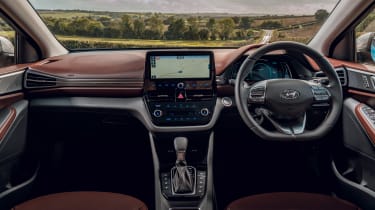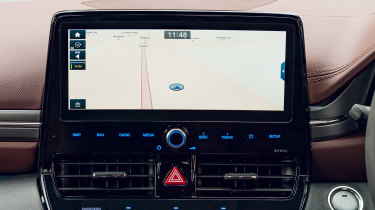Hyundai Ioniq (2016-2022) review - Interior, design and technology
Sleek shape and neat tech both appeal, but iffy build quality lets it down
Designing a hybrid from a clean sheet of paper (as Hyundai has done) allows designers to put big emphasis on aerodynamic efficiency to extract the best possible fuel economy. There’s not much point in maximising mpg from the drivetrain if a slab-like body shape with lots of drag undoes your hard work.
This much is obvious from the Ioniq’s styling, as the curving roofline and some clever aerodynamic details give it a slippery shape.
A car’s drag coefficient relates to the resistance created moving through the air; this is what designers strive to minimise, and in the Ioniq’s case, it’s a low 0.24. Actually, this is the same as the figure for the Toyota Prius, so it’s no surprise that these cars bear a striking resemblance to one another. The Ioniq’s low nose, gentle roofline and high, square tail give a similar look in profile, while both models feature a bar across the back dividing the large glass hatches.
The C-shaped LED running lights make it easy to pick the car out on the move, while a hexagonal grille connects the two sleek light units. A contrasting colour insert at the base of the bumper gives scope to personalise the car, with seven different colours to choose from.
At the rear, the bar that divides the boot lid also acts as a brow for the tail-lights and dark glass panel, while a glossy black plastic insert in the bumper breaks up the smooth surfaces at the back. Small 15-inch alloy wheels are standard, although optional 17-inch alloys are available.
Sat-nav, stereo and infotainment
Equipment levels are pretty good all round, with Premium SE models getting plenty of kit. Heated and ventilated leather seats are included, along with adaptive cruise control and automatic wipers.
More reviews
Car group tests
In-depth reviews
Long-term tests
Road tests
- New Hyundai Ioniq Electric 2020 review
- New Hyundai Ioniq Hybrid 2019 review
- New Hyundai Ioniq Plug-in 2017 review
- Hyundai Ioniq autonomous ride review
Used car tests
Since the facelift in 2019 all versions have been upgraded with an impressive new infotainment set-up, based around a big 10.25-inch touchscreen set on top of the redesigned dash. It’s an impressively configured set-up, but while other manufacturers have been moving towards buttons for climate control functions, Hyundai has bucked the trend and swapped formerly user-friendly scroll wheels for touchscreen controls.
Still, the touchscreen is a technology fest that puts the Prius somewhat to shame, and features a screen you can customise with a variety of widgets for functions such as climate, smartphone, navigation and audio controls. It’s also connected to the cloud, so you can get traffic info and live updates for charge point availability.
A BlueLink smartphone app has fun features that allow you to send nav destinations to your car, or pre-set the climate control remotely, as well as updating you on the charge state of PHEV and EV versions.
While there are no question marks over kit, there are a few over the build quality. The blue accents lift the sombre cabin, but some of the materials highlight the Ioniq’s cheaper price tag. The interior design is also more conventional than the Toyota’s, with the energy flow meter in the digital instrument cluster the only visual clue to the hybrid powertrain.






